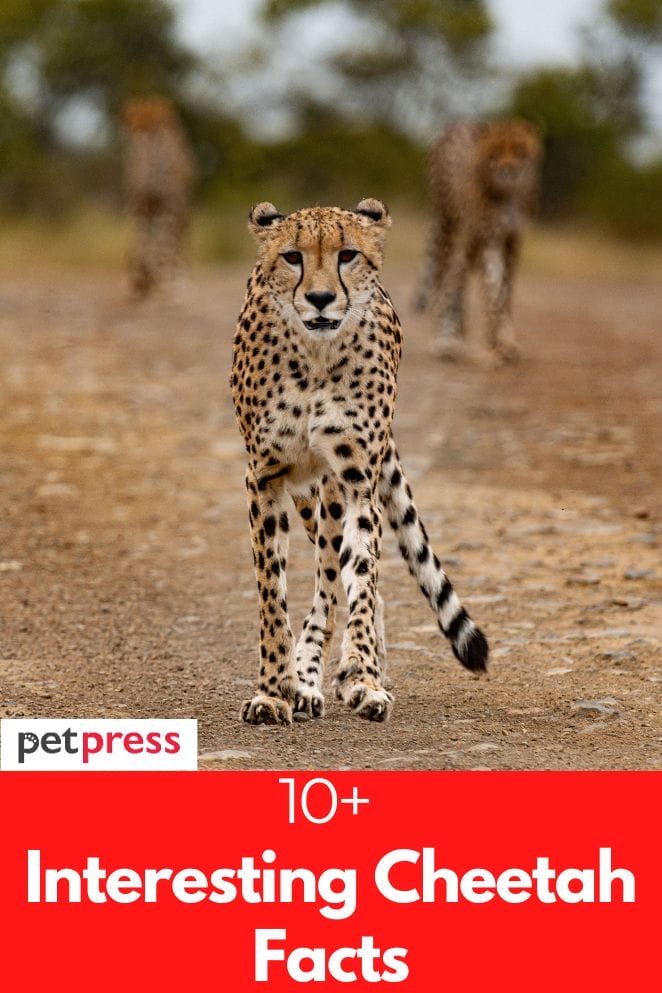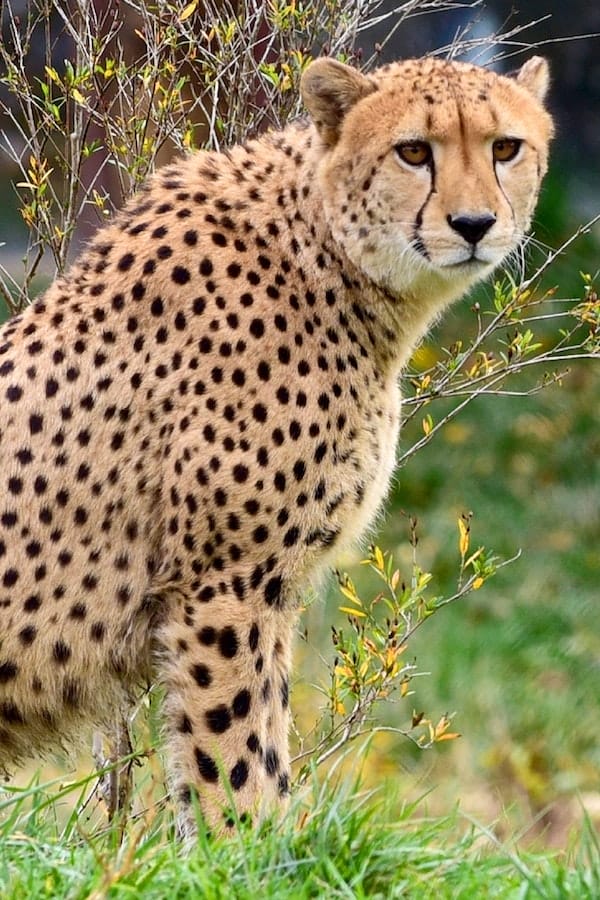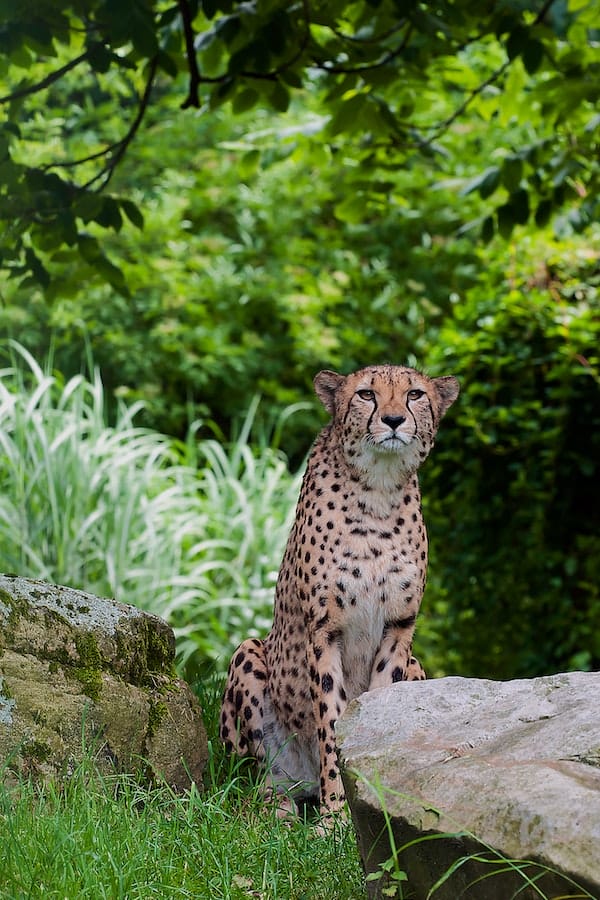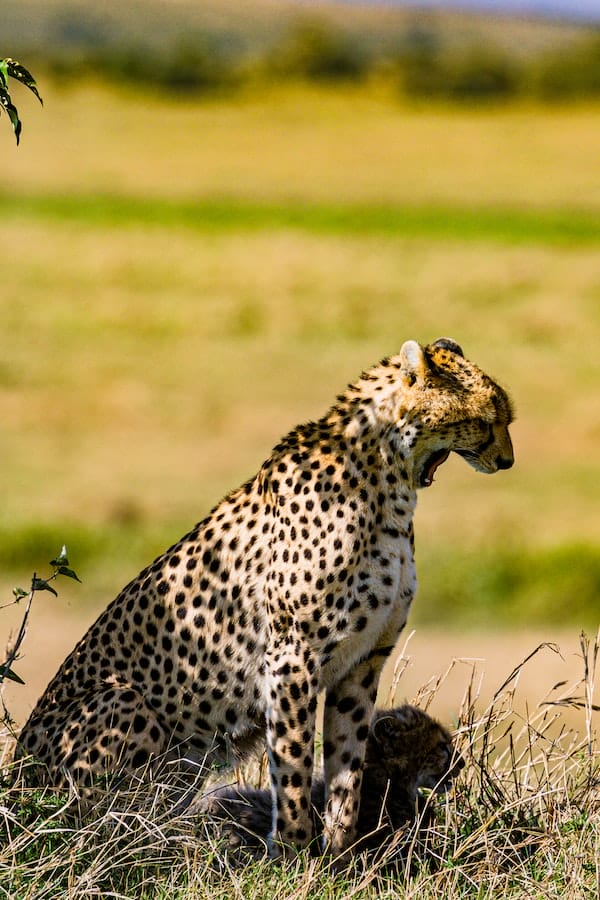
The cheetah is a graceful and fast-moving cat native to Africa and parts of Asia.
Known for its distinctive spotted coat, it is one of the world’s most recognizable big cats.
With an incredible top speed of nearly 70 miles per hour, the cheetah is an apex predator that dominates the African savannah with its impressive hunting abilities.
Despite its remarkable features, the cheetah is currently classified as vulnerable on the IUCN Red List due to habitat loss and fragmentation, poaching, and human conflict.
Here are some interesting facts about the cheetah:
Fact #1: Cheetahs are the fastest land animals in the world.
One of the most remarkable features of the cheetah is its incredible speed. With a top speed of nearly 70 miles per hour, it is the fastest land animal in the world.
This speed allows the cheetah to hunt and capture prey with stunning efficiency, allowing it to dominate the African savannah as an apex predator.
Fact #2: Cheetahs are members of the cat family.
The cheetah is a member of the cat family, which also includes lions, tigers, and leopards.
This diverse group of carnivorous mammals is characterized by their strong sense of sight and hearing, sharp teeth and claws, and ability to hunt and capture prey with speed and precision.
Despite their differences in size, location, and behavior, all cats share many common features that set them apart from other animals in the animal kingdom.
Fact #3: Cheetahs are native to Africa and Asia.

Cheetahs are native to Africa and Asia, inhabiting a wide range of habitats across these regions.
Although they prefer arid or semi-arid environments with plenty of open space, they can also be found in more temperate areas such as rainforests and mountain ranges.
Their adaptability and impressive hunting abilities allow them to survive and thrive in a variety of habitats, despite the challenges posed by changes in climate and habitat loss due to human development.
Fact #4: The scientific name for the cheetah is Acinonyx jubatus.
The scientific name for the cheetah is Acinonyx jubatus.
This unique and distinctive cat is characterized by its long, lean body, spotted coat, and powerful legs and claws.
Despite being one of the most recognizable big cats in the world, much remains to be learned about this fascinating species.
Fact #5: Cheetahs are carnivores, meaning that they eat meat.
Cheetahs are carnivores, meaning that they eat meat as their primary source of nutrition.
They typically feed on gazelles, antelopes, and rabbits in order to satisfy their high caloric needs.
Due to their large size and fast metabolism, cheetahs require a significant amount of protein-rich food in order to thrive in their environment.
Fact #6: Cheetahs are built for speed, with long legs and slim bodies.
The cheetah is a sleek, fast-moving cat with long legs and a slim body perfectly adapted for speed.
With its incredibly powerful legs, it is able to reach top speeds of nearly 70 miles per hour, making it the fastest land animal in the world.
Additionally, the cheetah uses its long tail as a dynamic balancing tool, allowing it to maintain its balance and agility while running at high speeds across the African savannah.
- Related post: How to Name Your Cheetah
Fact #7: Cheetahs typically live for 10-12 years in the wild and up to 20 years in captivity.

Cheetahs are long-lived animals, typically living for 10-12 years in the wild and up to 20 years in captivity.
This is longer than many other types of big cats, which tend to have shorter lifespans due to the challenges of life in the wild.
In order to survive and thrive in their environment, cheetahs must be agile, fast, and adaptable, all of which help to maximize their chances of survival over the course of their long lives.
Fact #8: Female cheetahs give birth to litters of anywhere from one to eight cubs at a time.
Female cheetahs typically give birth to litters of one to eight cubs at a time. After spending about 18 months with their mother, cubs will leave her and strike out on their own.
During this period of development, young cheetahs must learn how to hunt, navigate the landscape, and avoid predators in order to survive.
Fact #9: Cheetahs are shy and solitary animals.
Cheetahs are shy and solitary animals, typically avoiding contact with other cheetahs outside of their immediate family group.
They are particularly wary of other members of their species due to the high level of competition present in cheetah populations.
Despite being built for speed and agility, cheetahs prefer to minimize their interactions with others in order to avoid potential conflict and ensure their own survival.
Fact #10: Cheetahs are not very good at climbing trees.
While cheetahs are incredibly fast runners, they are not very good at climbing trees like other members of the cat family, such as lions and leopards.
This is likely due to their long, lean body shape, which is not well suited for climbing up tree trunks or navigating branches.
Despite this limitation, cheetahs have still managed to thrive in their environment, using their speed and agility to hunt prey and avoiding danger.
Fact #11: Cheetahs have been hunted by humans for their fur.

Cheetahs have long been a target for human hunters, who value their fur for its beautiful and distinctive markings.
However, due to habitat loss and hunting pressure, cheetahs are now considered an endangered species, with only a few thousand individuals remaining in the wild today.
This is largely due to human activities such as deforestation and poaching, which have resulted in the loss of critical cheetah habitats and increased competition for resources.
Fact #12: There are an estimated 7,500-10,000 cheetahs left in the wild today.
Despite being one of the most iconic and recognizable animals in the African savannah, cheetahs have been facing a serious decline in their population in recent years.
Estimates suggest that there are only 7,500-10,000 cheetahs remaining in the wild today, putting this species at risk of extinction.
This decline is largely due to human activities such as habitat loss and poaching, which have contributed to the loss of cheetah habitats and increased competition for resources.
Overall, the cheetah is an incredibly fascinating and unique animal, with many interesting characteristics that help to make it well adapted to its environment.
Despite facing numerous challenges in recent years due to human activities such as habitat loss and poaching, this species remains a vital part of the African savannah ecosystem and deserves our continued attention and protection.
To help protect and conserve this iconic species, we must continue to take steps to minimize human impacts on cheetah habitats and reduce the threat of poaching.
By working together, we can help ensure a bright future for the cheetah and other wildlife in Africa.


GIPHY App Key not set. Please check settings